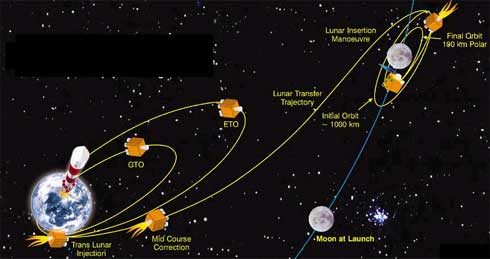Chandrayaan's space schedule
22 Oct 2008
With a ""beautiful, textbook launch" launch putting Chandrayaan into an earth orbit, now it's time to look at the schedule and activities that India's first lunar orbiter will undergo or perform over the coming days.
According to Indian Space Research Organisation chairman G Madhavan Nair the successful launch is a historic moment in India's space programme. "The launch was perfect and precise. The satellite has been placed in the earth orbit. With this, we have completed the first leg of the mission and it will take 15 days to reach the lunar orbit," Nair announced.

Right now the PSLV-C11 has left the spacecraft at a point in space that is 250 km from the earth at its closest (perigee) and 23,000 km at its farthest (apogee).
After circling the Earth in its initial orbit for a while, Chandrayaan-1 is taken into two more elliptical orbits whose apogees lie still higher at 37,000 km and 73,000 km respectively. "This is done at opportune moments by firing the spacecraft's Liquid Apogee Motor (LAM) when the spacecraft is near perigee. Subsequently, LAM is fired again to take the spacecraft to an extremely high elliptical orbit whose apogee lies at about 387,000 km," says ISRO announced plan of action.
In this orbit, the spacecraft makes one complete revolution around the earth in about 11 days. During its second revolution around the earth in this orbit, the spacecraft will approach the moon's North Pole at a safe distance of about a few hundred kilometres since the moon would have arrived there in its journey round the earth.
 "Once the Chandrayaan-1 reaches the vicinity of the moon, the spacecraft is oriented in a particular way and its LAM is again fired. This slows down the spacecraft sufficiently to enable the gravity of the moon to capture it into an elliptical orbit. Following this, the height of the spacecraft's orbit around the moon is reduced in steps. After a careful and detailed observation of perturbations in its intermediate orbits around the moon, the height of Chandrayaan-1 spacecraft's orbit will be finally lowered to its intended 100 km height from the lunar surface," an ISRO release says.
"Once the Chandrayaan-1 reaches the vicinity of the moon, the spacecraft is oriented in a particular way and its LAM is again fired. This slows down the spacecraft sufficiently to enable the gravity of the moon to capture it into an elliptical orbit. Following this, the height of the spacecraft's orbit around the moon is reduced in steps. After a careful and detailed observation of perturbations in its intermediate orbits around the moon, the height of Chandrayaan-1 spacecraft's orbit will be finally lowered to its intended 100 km height from the lunar surface," an ISRO release says.
This is expected to be achieved around 8 November.
The next important stage would be the ejection of the Moon Impact Probe from Chandrayaan-1 in a chosen area after which cameras and other payloads onboard would be turned on and thoroughly tested, marking the beginning of the operational phase of the mission.
This phase lasts about two years during which Chandrayaan-1 spacecraft explores the lunar surface with its array of instruments that includes cameras, spectrometers and its radar system.






























